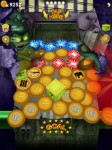
- Product description: Free-to-play carnival game.
- Release Date: Nov 24, 2010
- Product history/genesis: Original title (Coin Push Frenzy) was handed to me to clean up enough to release. After doing so, I recoded it in my game engine (theComplex) to create the iPad version. Re-used most artwork from the original game.
- Team: Self, Producer, Artist, QA team.
- Core Technologies: C++ game in theComplex engine supporting iPhone OpenGL, and partial Android OpenGL
- Most proud of: This was a very fast conversion. By this point my game engine had matured enough to allow this conversion of a very messy, zero commented, plain C codebase into a sleek and efficient game within a couple weeks.
- Responsibilities: All code and art integration
All of the 2d user interfaces were implemented using Interface Builder. theComplex was able to load xib files directly and create OpenGL-based objects with them. This also included support for any aspect ratio screen (as would be needed on Android).
There are actually two physics engines in use on this product. theComplex has bullet physics integrated into it, and this was used for almost every object. However, in the original game, all the coins that were directly on the face of the playfield were handled manually in a 2d-only, much simpler physics system. This was done as a performance optimization. The side effect was that a coin that dropped onto the playfield at a slight angle (say, by getting hung up on the pusher) would actually stick at that angle permanently as it moved down the playfield instead of laying flat as one would expect. The HD version of the game preserves this error, despite the fact that the improved engine did not need the optimization any longer.
When beginning this conversion, I built a few alternate models for the playfield to take advantage of the iPad’s larger display size. None of these alternate models made it into the final game, but the engine was able to play just fine with them.
Some of the most difficult things to reproduce in the new engine was the particle effects of the original. The original was based on redrawing everything every single frame, and the new engine is designed with a core concept of “assume it will exist in the next frame.” This was eventually handled by adding some particle system support to the engine, with dynamic vertex buffers. Up to this point, supporting both Apple’s vertex buffer standards and the ARB versions (for different hardware) was not that simple. But Apple had finally made the ARB versions available across all hardware which considerably simplified the task.
This was the first game based on theComplex game engine to run partially on Android devices. It could get into and display the main game board. I was unable to complete the port, as ngmoco had just purchased Freeverse and completely changed the technology direction behind our games, canning it.
An older (but more exciting!) portfolio page for this project.


